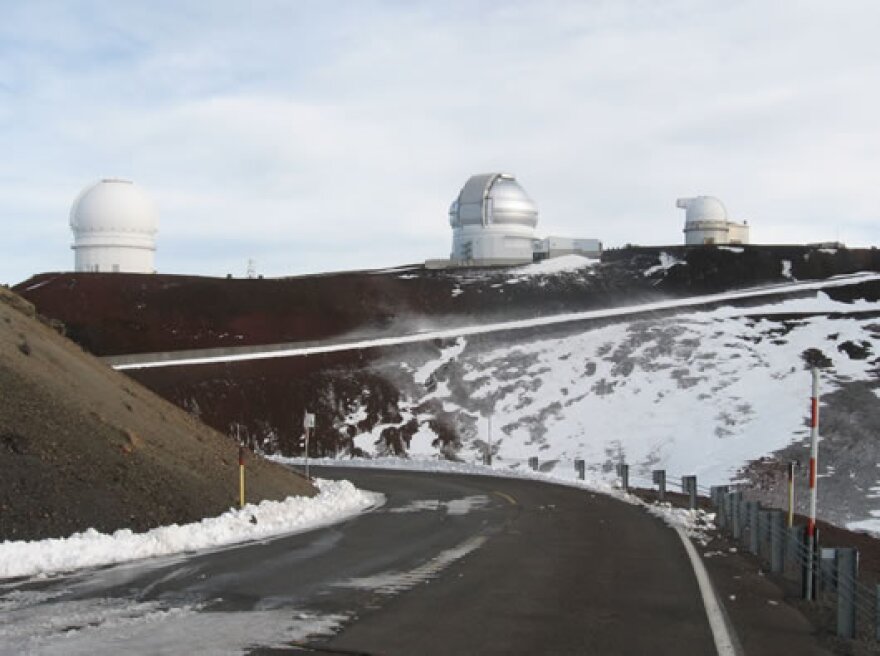HONOLULU — Two Hawaii legislative committees on Thursday passed a resolution creating a working group to develop recommendations for new management of the state's tallest mountain, Mauna Kea.
The peak is the site of a years-long dispute between those who support conducting world-leading astronomy research there and those who believe the modern telescopes desecrate a place many Native Hawaiians believe is sacred.
The University of Hawaii currently manages the summit under a 65-year lease from the state of Hawaii that's due to expire in 2033. Critics say the university has done a poor job of consulting Native Hawaiians since observatory construction began there in the late 1960s.
Today, the summit is home to about a dozen of the world's most advanced telescopes seeking to study space using the location's clear skies and limited air and light pollution.
The resolution calls for the House speaker to appoint the working group's chair as well as three members from the House of Representatives and seven Native Hawaiians nominated by indigenous organizations. The Office of Hawaiian Affairs, the Board of Land and Natural Resources, the university's Board of Regents and Mauna Kea Observatories would each designate one member.
The resolution didn't mention the Thirty Meter Telescope, a new observatory planned for the summit by an international consortium including the University of California and California Institute of Technology and the nations of Canada, China, India and Japan.
The consortium obtained state permits to build the telescope, but a group of mostly Native Hawaiian protesters in 2019 blocked the road leading to the summit so construction crews couldn't get there to build the facility. TMT has since suspended construction but continues to pursue the project.
Rep. Patrick Branco, a Democrat representing Kailua and Kaneohe Bay, said as Native Hawaiian he recognized the trauma, hurt, sadness and pain suffered by those involved.
"I do feel, though, that in discussion and hard discussions there can be resolution," Branco said as he voted to advance the resolution.
Rep. Dale Kobayashi, a Democrat who represents Manoa, voted "no," saying he questioned how fair the working group would be.
"It's going to be controlled by our Legislature here, a body that has overwhelmingly been in support of development of Mauna Kea and the building of TMT," Kobayashi said.
The House Water and Land Committee passed the resolution 5-0 while the Judiciary and Hawaiian Affairs Committee passed the resolution 11-2. It now goes to the full House for consideration.
Jessica Dempsey, deputy director of the East Asian Observatory which operates the James Clark Maxwell Telescope on the mountain, testified in favor of the resolution.
"We look forward to a chance to come together, to consider with care and respect all of the perspectives and ideas that might be had for a positive, inclusive and shared vision for the future of Mauna Kea," Dempsey said.
The University of Hawaii raised some concerns, saying that without a clearly stated purpose the resolution would cast even more uncertainty on the future of astronomy in Hawaii. Already, the school said, those who fund existing Mauna Kea telescopes are delaying investments because they believe Hawaii may be wavering in its commitment to the field.
Sylvia Hussey, the CEO of the Office of Hawaiian Affairs, testified that having one body determine the group's composition would undermine the integrity of the panel and whatever recommendations it proposes. She also said the working group should specifically include Native Hawaiian lineal descendants and cultural practitioners from Hawaii Island who have sought to ensure better management and care of the mountain.
Despite the resolution's failure to mention TMT, Healani Sonoda-Pale of the political action committee Ka Lahui Hawaii said it was really about thwarting ki'ai, or protectors who blocked construction crews from reaching the summit.
"We don't see this as a way to discuss management. We see this as a backdoor into finding a way to silence ki'ai and to build TMT," Sonoda-Pale testified.



